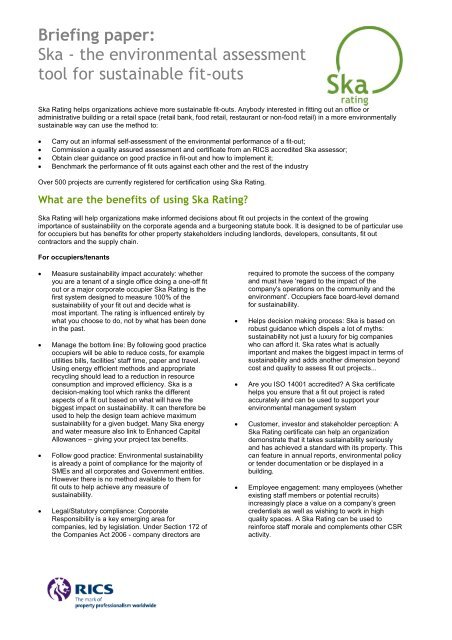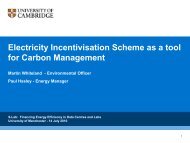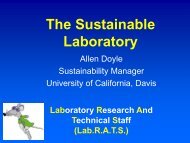Briefing paper Ska - the environmental assessment tool for sustainable fit-outs
Ska - the environmental assessment tool for ... - Eventlink.org
Ska - the environmental assessment tool for ... - Eventlink.org
- No tags were found...
Create successful ePaper yourself
Turn your PDF publications into a flip-book with our unique Google optimized e-Paper software.
<strong>Briefing</strong> <strong>paper</strong>:<strong>Ska</strong> - <strong>the</strong> <strong>environmental</strong> <strong>assessment</strong><strong>tool</strong> <strong>for</strong> <strong>sustainable</strong> <strong>fit</strong>-<strong>outs</strong><strong>Ska</strong> Rating helps organizations achieve more <strong>sustainable</strong> <strong>fit</strong>-<strong>outs</strong>. Anybody interested in <strong>fit</strong>ting out an office oradministrative building or a retail space (retail bank, food retail, restaurant or non-food retail) in a more <strong>environmental</strong>ly<strong>sustainable</strong> way can use <strong>the</strong> method to:Carry out an in<strong>for</strong>mal self-<strong>assessment</strong> of <strong>the</strong> <strong>environmental</strong> per<strong>for</strong>mance of a <strong>fit</strong>-out;Commission a quality assured <strong>assessment</strong> and certificate from an RICS accredited <strong>Ska</strong> assessor;Obtain clear guidance on good practice in <strong>fit</strong>-out and how to implement it;Benchmark <strong>the</strong> per<strong>for</strong>mance of <strong>fit</strong> <strong>outs</strong> against each o<strong>the</strong>r and <strong>the</strong> rest of <strong>the</strong> industryOver 500 projects are currently registered <strong>for</strong> certification using <strong>Ska</strong> Rating.What are <strong>the</strong> bene<strong>fit</strong>s of using <strong>Ska</strong> Rating?<strong>Ska</strong> Rating will help organizations make in<strong>for</strong>med decisions about <strong>fit</strong> out projects in <strong>the</strong> context of <strong>the</strong> growingimportance of sustainability on <strong>the</strong> corporate agenda and a burgeoning statute book. It is designed to be of particular use<strong>for</strong> occupiers but has bene<strong>fit</strong>s <strong>for</strong> o<strong>the</strong>r property stakeholders including landlords, developers, consultants, <strong>fit</strong> outcontractors and <strong>the</strong> supply chain.For occupiers/tenantsMeasure sustainability impact accurately: whe<strong>the</strong>ryou are a tenant of a single office doing a one-off <strong>fit</strong>out or a major corporate occupier <strong>Ska</strong> Rating is <strong>the</strong>first system designed to measure 100% of <strong>the</strong>sustainability of your <strong>fit</strong> out and decide what ismost important. The rating is influenced entirely bywhat you choose to do, not by what has been donein <strong>the</strong> past.Manage <strong>the</strong> bottom line: By following good practiceoccupiers will be able to reduce costs, <strong>for</strong> exampleutilities bills, facilities' staff time, <strong>paper</strong> and travel.Using energy efficient methods and appropriaterecycling should lead to a reduction in resourceconsumption and improved efficiency. <strong>Ska</strong> is adecision-making <strong>tool</strong> which ranks <strong>the</strong> differentaspects of a <strong>fit</strong> out based on what will have <strong>the</strong>biggest impact on sustainability. It can <strong>the</strong>re<strong>for</strong>e beused to help <strong>the</strong> design team achieve maximumsustainability <strong>for</strong> a given budget. Many <strong>Ska</strong> energyand water measure also link to Enhanced CapitalAllowances – giving your project tax bene<strong>fit</strong>s.Follow good practice: Environmental sustainabilityis already a point of compliance <strong>for</strong> <strong>the</strong> majority ofSMEs and all corporates and Government entities.However <strong>the</strong>re is no method available to <strong>the</strong>m <strong>for</strong><strong>fit</strong> <strong>outs</strong> to help achieve any measure ofsustainability.Legal/Statutory compliance: CorporateResponsibility is a key emerging area <strong>for</strong>companies, led by legislation. Under Section 172 of<strong>the</strong> Companies Act 2006 - company directors arerequired to promote <strong>the</strong> success of <strong>the</strong> companyand must have ‘regard to <strong>the</strong> impact of <strong>the</strong>company's operations on <strong>the</strong> community and <strong>the</strong>environment’. Occupiers face board-level demand<strong>for</strong> sustainability.Helps decision making process: <strong>Ska</strong> is based onrobust guidance which dispels a lot of myths:sustainability not just a luxury <strong>for</strong> big companieswho can af<strong>for</strong>d it. <strong>Ska</strong> rates what is actuallyimportant and makes <strong>the</strong> biggest impact in terms ofsustainability and adds ano<strong>the</strong>r dimension beyondcost and quality to assess <strong>fit</strong> out projects...Are you ISO 14001 accredited? A <strong>Ska</strong> certificatehelps you ensure that a <strong>fit</strong> out project is ratedaccurately and can be used to support your<strong>environmental</strong> management systemCustomer, investor and stakeholder perception: A<strong>Ska</strong> Rating certificate can help an organizationdemonstrate that it takes sustainability seriouslyand has achieved a standard with its property. Thiscan feature in annual reports, <strong>environmental</strong> policyor tender documentation or be displayed in abuilding.Employee engagement: many employees (whe<strong>the</strong>rexisting staff members or potential recruits)increasingly place a value on a company’s greencredentials as well as wishing to work in highquality spaces. A <strong>Ska</strong> Rating can be used torein<strong>for</strong>ce staff morale and complements o<strong>the</strong>r CSRactivity.
For developers and landlordsAttract and engage tenants by providing <strong>sustainable</strong> ‘CAT A’ office spaceUse <strong>Ska</strong> Rating to set targets, <strong>the</strong>n use <strong>the</strong> <strong>for</strong>mal <strong>assessment</strong> process to assure yourself that target per<strong>for</strong>mancestandards are met, and finally use <strong>the</strong> certificate to report <strong>the</strong>ir per<strong>for</strong>mance to stakeholders. Then benchmark <strong>the</strong>sustainability of <strong>fit</strong> <strong>outs</strong> across a portfolio of buildings.Include <strong>the</strong> use of <strong>the</strong> RICS <strong>Ska</strong> Rating in license to alter and Green Lease provisions to help drive up <strong>the</strong>sustainability of properties or protect a building already certified under a whole building <strong>assessment</strong> method.Sustainability increasingly makes good business sense. Research demonstrates an expected increase in <strong>the</strong> assetvalue of labelled low carbon buildings compared with standard speculative buildings.For consultants and contractorsEmbed <strong>Ska</strong> Rating in your standard processes to demonstrate that you follow a <strong>sustainable</strong> specification andprocurement process <strong>for</strong> <strong>fit</strong> out.Use <strong>the</strong> <strong>Ska</strong> Rating <strong>tool</strong> and datasheets to support delivery of professional advice to clients on good practice in<strong>sustainable</strong> <strong>fit</strong> out and to assess <strong>the</strong>ir designs and projectsOffer <strong>Ska</strong> Rating certificated <strong>assessment</strong>s to clients who wish to demonstrate <strong>the</strong>y have achieved more <strong>sustainable</strong><strong>fit</strong> out through <strong>the</strong> <strong>Ska</strong> Accredited Assessors schemeHow it worksNo matter what your starting point a <strong>Ska</strong> Rating will enable you to measure 100% of <strong>the</strong> <strong>environmental</strong> per<strong>for</strong>mance ofan office <strong>fit</strong>-out. Since <strong>Ska</strong> Rating does not consider <strong>the</strong> base build it measures only what you do to add value to yourproperty. Key aspects of <strong>the</strong> rating system are:Flexible scoping – match <strong>the</strong> rating to <strong>the</strong> scope of <strong>the</strong> <strong>fit</strong>-outEasy to use, free online <strong>tool</strong> https://ska-<strong>tool</strong>.rics.org/A label that is clear and easy to understand: Bronze, Silver Gold plus % score.Formal quality assured scheme <strong>for</strong> those who require a certificate
Good practice and guidance<strong>Ska</strong> Rating <strong>for</strong> Offices comprises 104 good practice measures across Energy & CO2, Waste, Water, Pollution,Transport, Materials and Wellbeing. <strong>Ska</strong> Rating <strong>for</strong> Retail has 112 measures. E.g. when wooden flooring is stripped outit should be sent <strong>for</strong> re-use to a salvage yard instead to landfill. For a complete list of measures refer to <strong>the</strong> GoodPractice Guidance sectionMeasures in scopeEach good practice measure is explained in a datasheet explaining <strong>the</strong> criteria that need to be achieved, <strong>the</strong> rationalebehind <strong>the</strong> measure and guidance on how to achieve it. Because each <strong>fit</strong> out project is unique in terms of employers’requirements, <strong>the</strong> building/ site and scope of works, <strong>Ska</strong> Rating scores <strong>the</strong> project on basis only of those measures thatare relevant to <strong>the</strong> project. These are called ‘Measures In Scope’. Typically between 30 and 60 measures are likely toapply to most projects. The score is ranked in 3 thresholds Gold, Silver and Bronze. These thresholds are reached byachieving 75%, 50% or 25%, respectively, of <strong>the</strong> measures in scope.What are ‘Gateway’ measures?Because some measures are more important from a sustainability perspective <strong>the</strong> measures are ranked from 1 to 99, (1is <strong>the</strong> highest and 99 <strong>the</strong> lowest). To ensure that teams do not just target <strong>the</strong> easiest measures, <strong>the</strong> project has toachieve a number of <strong>the</strong> highest ranked measures in scope in order to score; <strong>the</strong>ses are known as Gateway Measures.The <strong>assessment</strong> processAs with any <strong>fit</strong> out project <strong>the</strong> <strong>Ska</strong> <strong>assessment</strong> process is broken into three stages:1. Design At this stage we identify <strong>the</strong> measures and issues in scope. Once <strong>the</strong> Measures in Scope are identified <strong>the</strong>client has <strong>the</strong> opportunity to prioritise which measures <strong>the</strong>y want to achieve and make a decision against design,cost, programme and bene<strong>fit</strong>, and add <strong>the</strong>m into <strong>the</strong> scope of works <strong>for</strong> <strong>the</strong> project. This will also set <strong>the</strong><strong>environmental</strong> per<strong>for</strong>mance standards <strong>for</strong> how <strong>the</strong> project is delivered, in terms of waste and energy in use etc. Thenif <strong>the</strong> specification demonstrates that <strong>the</strong>se measures are likely to be achieved <strong>the</strong>y will be reflected in an indicativerating.2. Handover. This involves <strong>the</strong> ga<strong>the</strong>ring of evidence from O&M manuals and o<strong>the</strong>r sources to prove that what hasbeen specified has actually been delivered and that <strong>the</strong> per<strong>for</strong>mance and waste benchmarks have been achieved.3. Occupancy. Finally <strong>the</strong>re is <strong>the</strong> option to review how well a <strong>fit</strong> out has per<strong>for</strong>med in use against its original brief froma year after completion.How to become a <strong>Ska</strong> Accredited AssessorRICS operates an accreditation scheme to enable qualified professionals to undertake quality-assured <strong>Ska</strong> Rating<strong>assessment</strong>s on behalf of organizations. Only <strong>Ska</strong> Accredited Assessors are able to <strong>for</strong>mally certificate projects althoughanyone is free to use <strong>the</strong> online <strong>Ska</strong> Rating <strong>tool</strong> to in<strong>for</strong>mally evaluate a project. Since 2009 RICS has trained 200accredited assessors.Accreditation involves attending a one-day Foundations training course, and <strong>the</strong>n completing and passing an onlinemodule and exam (one <strong>for</strong> offices and one <strong>for</strong> retail)and <strong>the</strong>n joining ei<strong>the</strong>r <strong>the</strong> relevant accreditation scheme andregister. This training provides an in-depth explanation of <strong>the</strong> <strong>Ska</strong> Rating system. The course consists of presentations,exercises and interactive use of <strong>the</strong> online <strong>tool</strong>. There is a multiple choice exam at <strong>the</strong> end of <strong>the</strong> second day. Successfulcompletion of this exam will enable you to become a qualified assessor.Contents of <strong>the</strong> training includes:1. The <strong>Ska</strong> Rating philosophy and methodology explained2. Good practice measures <strong>for</strong> energy and CO2, water, waste, materials, pollution, transport and wellbeing3. How to carry out an <strong>assessment</strong> using <strong>the</strong> online <strong>tool</strong>4. How to work with <strong>the</strong> design team5. Exam leading to accreditationWhy should you attend? To gain <strong>the</strong> knowledge required to become a <strong>Ska</strong> Accredited Assessor To obtain an in-depth understanding of <strong>the</strong> philosophy and method underlying <strong>the</strong> <strong>Ska</strong> rating system To learn how to apply <strong>the</strong> system in <strong>the</strong> context of <strong>the</strong> design and construction process To develop a detailed understanding of <strong>the</strong> sustainability issues relevant to <strong>the</strong> office-<strong>fit</strong> out process.Who should attend?The Foundations course is designed <strong>for</strong> all building professionals who are involved in building and <strong>fit</strong>ting out offices. Forexample surveyors, building surveyors, project managers, facility managers, construction managers and sustainability
assessors who are involved in office <strong>fit</strong>-out. The Assessor Modules are suited to those wishing to become activeassessors.The bene<strong>fit</strong>s of accreditationRICS’s accreditation scheme exists to quality assure and regulate professionals who wish to offer clients certificationusing <strong>the</strong> <strong>Ska</strong> Rating method on <strong>fit</strong>-<strong>outs</strong>. Candidates who pass <strong>the</strong> exam will be enrolled onto an RICS register of accredited assessors Gain authority to <strong>for</strong>mally certificate projects <strong>for</strong> clients Simple pay-as-you-go charge when you submit a project <strong>for</strong> certification includes lodgement, storage and monitoringYou will automatically join an online community of Accredited Assessors hosted by RICSCPD is offered to keep you abreast of changes to <strong>the</strong> <strong>Ska</strong> Rating method – <strong>the</strong>re is an annual requirement <strong>for</strong>assessors.Frequently asked questionsWhat is <strong>the</strong> <strong>Ska</strong> Rating?An <strong>environmental</strong> labelling method designed to rate and compare <strong>the</strong> <strong>environmental</strong> per<strong>for</strong>mance of <strong>fit</strong>-out projectsinitially <strong>for</strong> office buildings in <strong>the</strong> UK. Developed by industry <strong>for</strong> industry, <strong>Ska</strong> Rating is designed to encourage goodpractice in <strong>fit</strong> out work and has been developed collaboratively by consultants, contractors and occupiers.Why focus on <strong>the</strong> <strong>fit</strong> out sector?The <strong>fit</strong> out sector is currently underserved with specific benchmarks and labelling although it is a substantial part of <strong>the</strong>construction industry. <strong>Ska</strong> Rating is intended to fill this gap. The UK construction industry spent £64.5bn in <strong>the</strong> years2003-06; of this £6.9bn was attributed to <strong>the</strong> <strong>fit</strong>-out sector. This represents 10% of <strong>the</strong> construction sector budget.Source: Office <strong>for</strong> National StatisticsIs sustainability still as important in a worsening economic climate?The current economic climate is extending real-estate life-expectancy. Occupiers are now more likely to refurbish <strong>the</strong>irexisting offices than seek new ones but while <strong>the</strong>re are proven methods <strong>for</strong> labelling <strong>the</strong> <strong>environmental</strong> per<strong>for</strong>mance ofwhole buildings, <strong>fit</strong> out has remained a sustainability blind spot. <strong>Ska</strong> Rating aims to rate only <strong>the</strong> <strong>environmental</strong>per<strong>for</strong>mance related to <strong>the</strong> scope of <strong>fit</strong>-out projects.What about o<strong>the</strong>r <strong>environmental</strong> labels such as BREEAM and LEED?<strong>Ska</strong> complements o<strong>the</strong>r labelling methods. <strong>Ska</strong> Rating labels 100% of <strong>the</strong> <strong>environmental</strong> per<strong>for</strong>mance related to <strong>the</strong> sscope of <strong>fit</strong>-out projects, irrespective of <strong>the</strong> base building. It can be used in conjunction with or alongside o<strong>the</strong>r ‘wholebuilding labels.How much will it cost to use <strong>the</strong> <strong>Ska</strong> Rating?It has been a principle from <strong>the</strong> <strong>outs</strong>et that <strong>Ska</strong> Rating should be free to use. It is designed to be accessible even <strong>for</strong> <strong>the</strong>smallest organization. All <strong>the</strong> in<strong>for</strong>mation about <strong>the</strong> rating method, criteria and guidance is available free on <strong>the</strong> web. Useof <strong>the</strong> online <strong>assessment</strong> <strong>tool</strong> is also free <strong>for</strong> those who want to self-assess. Those wanting a quality-assured certificateto <strong>for</strong>mally substantiate <strong>the</strong>ir per<strong>for</strong>mance will need to commission a <strong>for</strong>mal <strong>assessment</strong> from a <strong>Ska</strong>What will a <strong>for</strong>mal <strong>assessment</strong> and certificate cost?For businesses seeking <strong>the</strong> credibility of a professional certificate an assessor can be engaged to rate and certify <strong>the</strong>project an accredited <strong>Ska</strong> Rating assessor. Individual accredited assessors are free to set <strong>the</strong>ir own <strong>assessment</strong> feescorresponding to <strong>the</strong> time required to ga<strong>the</strong>r in<strong>for</strong>mation and complete <strong>the</strong> <strong>assessment</strong> record. It is likely that manyclients of <strong>the</strong> <strong>for</strong>mal <strong>assessment</strong> process will also want additional support and guidance depending on <strong>the</strong> scope, scaleand duration of <strong>the</strong> <strong>fit</strong>-out. The fees will include <strong>the</strong> cost of producing and lodging a <strong>Ska</strong> Rating certificate with <strong>the</strong> RICS.Can <strong>Ska</strong> rating be used in countries o<strong>the</strong>r than <strong>the</strong> UK?The principles of <strong>Ska</strong> Rating can apply to any <strong>fit</strong> out project but <strong>the</strong> guidance has been developed in <strong>the</strong> context of <strong>the</strong>UK regulatory framework. To contact RICS about adapting <strong>Ska</strong> <strong>for</strong> use in a different market please email ska@rics.orgWhy is it called ‘<strong>Ska</strong>’?When <strong>the</strong> rating system started life as a research project initiated and sponsored by <strong>Ska</strong>nsen (an interior <strong>fit</strong>-outcontractor) it quickly ga<strong>the</strong>red <strong>the</strong> working title ‘SKA’ based on <strong>the</strong> first three letters of <strong>Ska</strong>nsen’s name. We thoughtabout lots of o<strong>the</strong>r names but over time <strong>the</strong> name stuck. We think it’s quite catchy and memorable.Contact usEmail your query to ska@rics.org providing as much detailed in<strong>for</strong>mation as possible to help us answer your question.Or visit our website www.rics.org/ska to view a range of case studies.






